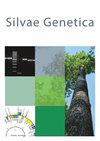基于遗传参数时间趋势的冷杉早期选择最佳时机估计
IF 1
4区 农林科学
Q3 FORESTRY
引用次数: 1
摘要
摘要在林木育种中,早期选择是必不可少的。本研究估计了冷杉(Abies sachalinensis (F. Schmidt) Mast)早期选择的最佳时机。根据从两个试验点获得的遗传参数的时间趋势。分析5、10(11)、15、20、30、40年树龄的树高(Ht)和20、30、40年树龄的胸径(DBH)。根据狭义遗传力(h2)和年龄-年龄遗传相关性(r)估算了早期间接选择相对于早期轮作年龄(40岁)进行直接选择的每年早期选择效率(E), Ht的h2在10岁和15岁时达到峰值(0.52 ~ 0.71),DBH在20岁时达到最高(0.19或0.22)。不同树龄树高和树高与胸径的年龄-年龄遗传相关性随着树龄差异的增大而降低(回归系数分别为- 0.011和- 0.007)。10岁和15岁时E值最高(Ht和Ht- dbh分别为0.84 ~ 1.74和1.42 ~ 2.24),为最佳选择时机。在日本林业中,最初的生长率被认为是降低除草成本的重要因素。10岁或15岁时的间接遗传增益比5岁时的直接遗传增益高65%以上;因此,考虑到树木生长的初始和成熟阶段,选择在10-15年的树龄是合适的。本文章由计算机程序翻译,如有差异,请以英文原文为准。
Estimation of optimal timing of early selection based on time trends of genetic parameters in Abies sachalinensis
Abstract Early selection is an imperative in ongoing forest tree breeding. This study estimated the optimal timing of early selection in Abies sachalinensis (F. Schmidt) Mast. based on time trends of genetic parameters obtained from two test sites. Tree height (Ht) at 5, 10 (11), 15, 20, 30, and 40 years of age and diameter at breast height (DBH) at 20, 30, and 40 years of age were analyzed. The efficiency of early selection per year (E) for performing early indirect selection relative to performing direct selection at the earliest rotation age (40 years of age) was estimated based on narrow-sense heritability (h2) and age–age genetic correlation (r). The h2 of Ht peaked at 10 or 15 years of age (0.52–0.71), and that of DBH was the highest at 20 years of age (0.19 or 0.22). The age–age genetic correlation between tree heights or between tree height and DBH at different ages decreased with increasing differences between ages (regression coefficients were −0.011 and −0.007, respectively). The E values were highest at 10 or 15 years of age (0.84-1.74 and 1.42-2.24 for Ht and Ht-DBH, respectively), indicating the optimum selection timing. In Japapnese forestry, the initial growth rate is considered important for reducing weeding costs. Selection at 10 or 15 years of age had more than in >65 % indirect genetic gain relative to the direct genetic gain at 5 years of age; thus, selection at 10-15 years of age is appropriate considering the initial and mature phases of tree growth.
求助全文
通过发布文献求助,成功后即可免费获取论文全文。
去求助
来源期刊

Silvae Genetica
农林科学-林学
CiteScore
2.20
自引率
10.00%
发文量
10
审稿时长
3 months
期刊介绍:
Silvae Genetica is an international peer reviewed journal with more than 65 year tradition and experience in all fields of theoretical and applied Forest Genetics and Tree breeding. It continues "Zeitschrift für Forstgenetik und Forstpflanzenzüchtung" (Journal of Forest Genetics and Forest Tree Breeding) founded by W. LANGNER in 1951.
 求助内容:
求助内容: 应助结果提醒方式:
应助结果提醒方式:


